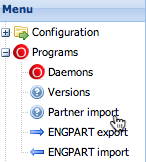Seon Enterprise partner migration
Seon Enterprise offers various import possibilities of hierarchical data of partner information. If none of the offeres solutions fits your needs, please contact us in order to search for a valid solution, we will help you out.
Doing
Most partner import processes are executed via the administrative web interface. Locate the menu entry point "Programs" -> "Partner import":
Daxware import
Daxware 2002 installations can export their partner information in CSV format, so the two steps have to be executed in the following order:
- Import "partner companies and locations" CSV
- Import "departments and recipients" CSV
The second step is based on the first step, so it would make no sense to switch the order of import.
EurexC
The import of EurexC based systems can be divided in two supported versions:
- Versions of EurexC CAD base which have the partner configuration in a file named "
xx020.d" - Versions of EurexC CAD base which have the partner configuration in a file named "
xx030.d"
When enabling the checkbox "Purge existing partners before migration", all partners will be deleted before migration starts.
When enabling the checkbox "Create dummy hierarchy for Seon Enterprise", a location with the same name as the partner is created for every entry. In this location, a department "OFTP" is added, where a user "Admin" is being added.
All special characters, i.e. german umlauts, are converted to newline due to the fact that the encoding is unknown.
WinElke
WinElke systems which are based on MS Access databases can be imported on a limited amount of platforms which support the binaries for the required tools. Just upload the MS Access file if the button is enabled.
SWAN 3.x
The partner databae schema must exist in the same database which Seon is working on. If the underlying tables exist, but the button is disabled, please contact us in order to verify your (possibly inconsistent) data.
Generic CSV
Via the Daxware import possibility, you can generate CSV files with a given format in order to import your partner data. The format of the files must follow a fix syntax.
The CSV for companies and locations (in one file) must contain exactly this following header line as the first line to be contained in the CSV file:
Companyname;Street;Housenumber;PostalCode;City;Country;Phonenumber;Fax;SSID;SFID;Net;Address;Password;Characterset;Fileformat;Recordsize;
The second file for departments and recipients must contain exactly this following header line as the first line to be contained in the CSV file:
Companyname;Companylocation;Lastname;Firstname;Phonenumber;Mobilenumber;Faxnumber;eMail;Department;Password;Userrole;
The references between the two files are the names of the company (1. "Companyname" = 2. "Companyname" )and the location name 1. "City" = 2. "Companylocation").
The field names indicate the value of the entity. Some words about special values:
- Companies and locations CSV:
Net: The textual value "ISDN" masks this as an ISDN connectivity partner, the given address is then the ISDN number. Otherwise, it's implicitely a TCP/IP connection partner, the address is then the TCP/IP hostname or IP address.- The own values of the local SSID, SFID and password are taken from the configuration of "Odette parameters" in the section "Configuration"
- all partner companies with the same name are being updated; all others are inserted
- Departments and recipients CSV:
- Entries with the same department, same company, same first name and same last name are updated; all others are inserted
- all departments of a given location with the same department name are being updated; all others are inserted
